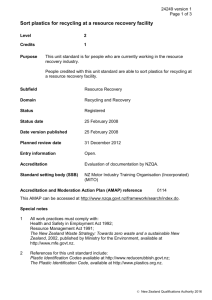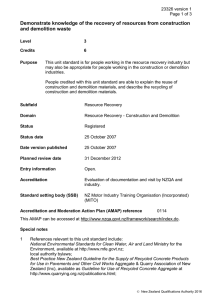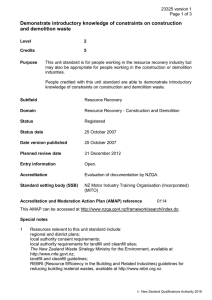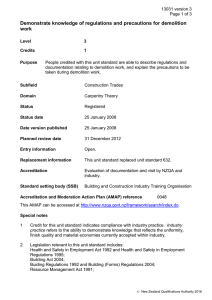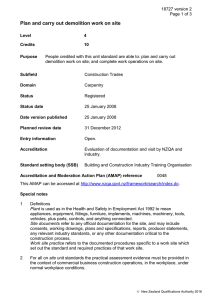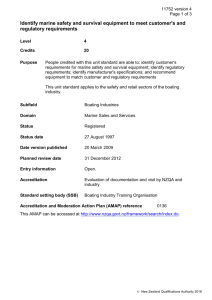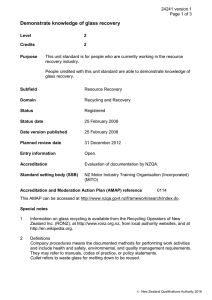23324 Identify construction and demolition waste materials
advertisement
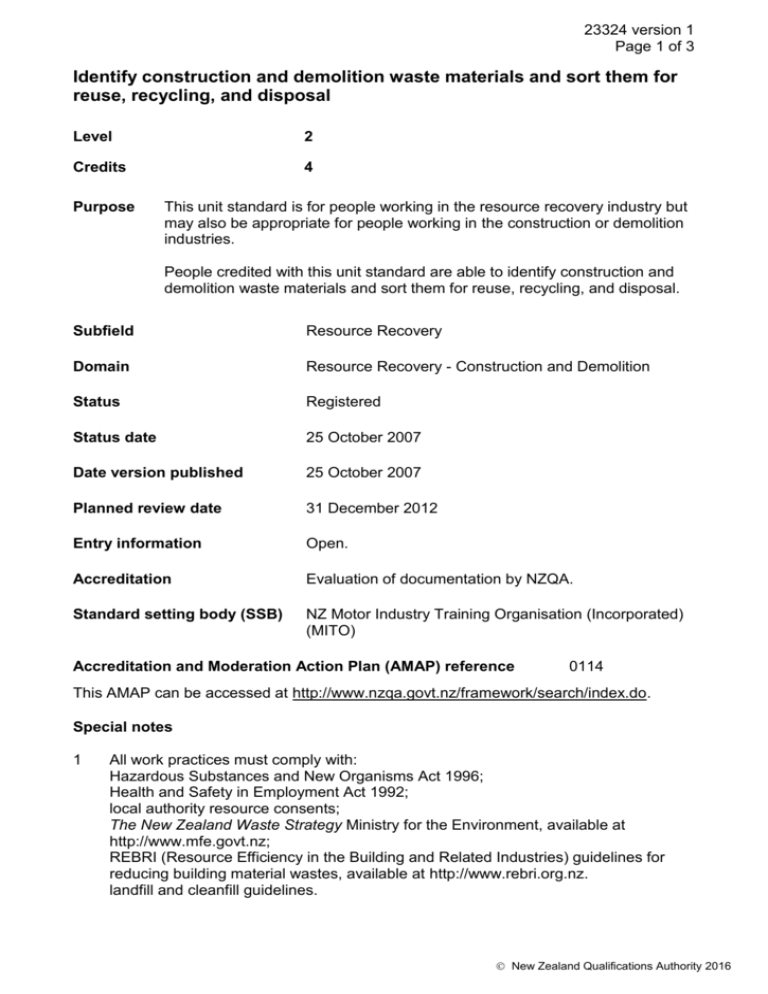
23324 version 1 Page 1 of 3 Identify construction and demolition waste materials and sort them for reuse, recycling, and disposal Level 2 Credits 4 Purpose This unit standard is for people working in the resource recovery industry but may also be appropriate for people working in the construction or demolition industries. People credited with this unit standard are able to identify construction and demolition waste materials and sort them for reuse, recycling, and disposal. Subfield Resource Recovery Domain Resource Recovery - Construction and Demolition Status Registered Status date 25 October 2007 Date version published 25 October 2007 Planned review date 31 December 2012 Entry information Open. Accreditation Evaluation of documentation by NZQA. Standard setting body (SSB) NZ Motor Industry Training Organisation (Incorporated) (MITO) Accreditation and Moderation Action Plan (AMAP) reference 0114 This AMAP can be accessed at http://www.nzqa.govt.nz/framework/search/index.do. Special notes 1 All work practices must comply with: Hazardous Substances and New Organisms Act 1996; Health and Safety in Employment Act 1992; local authority resource consents; The New Zealand Waste Strategy Ministry for the Environment, available at http://www.mfe.govt.nz; REBRI (Resource Efficiency in the Building and Related Industries) guidelines for reducing building material wastes, available at http://www.rebri.org.nz. landfill and cleanfill guidelines. New Zealand Qualifications Authority 2016 23324 version 1 Page 2 of 3 2 Hazard controls, safety procedures, and personal protective equipment must be used throughout operations in accordance with company procedures. 3 Assessment for this unit standard may take place at a site where the materials are sourced or at a recycling facility. 4 Definitions Company procedures means the documented methods for performing work activities and include health and safety, environmental, and quality management requirements. They may refer to manuals, codes of practice, or policy statements. MDF means medium density fibreboard. Elements and performance criteria Element 1 Identify construction and demolition waste materials and sort them for reuse, recycling, and disposal. Performance criteria 1.1 Materials are identified in accordance with company procedures and REBRI guidelines. Range 1.2 concrete and rubble, plasterboard, glass, plastics, fixtures, fittings; timber – treated, untreated, MDF, hardwood, softwood, particle board, off cuts, framing, cladding, demolition grade; metal – ferrous, nonferrous, roofing iron, reinforcing, wiring, pipes. Materials are sorted for reuse and recycling in accordance with company procedures and REBRI guidelines. Range timber, metal, concrete and rubble, plasterboard, glass, plastics, fixtures and fittings. 1.3 Sorting ensures that containers are filled to comply with permitted weights in accordance with company procedures. 1.4 Residual materials are identified and sorted for disposal in accordance with company procedures, and cleanfill and/or landfill guidelines. 1.5 Hazardous and special wastes are identified and reported in accordance with company procedures, local authority requirements, and The New Zealand Waste Strategy. Range may include but is not limited to – asbestos, gas cylinder, oil, cured bituminous products, paint, glue, thinners, acids, batteries, corrosive products; evidence is required of at least four items. New Zealand Qualifications Authority 2016 23324 version 1 Page 3 of 3 Please note Providers must be accredited by NZQA, or an inter-institutional body with delegated authority for quality assurance, before they can report credits from assessment against unit standards or deliver courses of study leading to that assessment. Industry Training Organisations must be accredited by NZQA before they can register credits from assessment against unit standards. Accredited providers and Industry Training Organisations assessing against unit standards must engage with the moderation system that applies to those standards. Accreditation requirements and an outline of the moderation system that applies to this standard are outlined in the Accreditation and Moderation Action Plan (AMAP). The AMAP also includes useful information about special requirements for organisations wishing to develop education and training programmes, such as minimum qualifications for tutors and assessors, and special resource requirements. Comments on this unit standard Please contact the NZ Motor Industry Training Organisation (MITO) info@mito.org.nz if you wish to suggest changes to the content of this unit standard. New Zealand Qualifications Authority 2016
